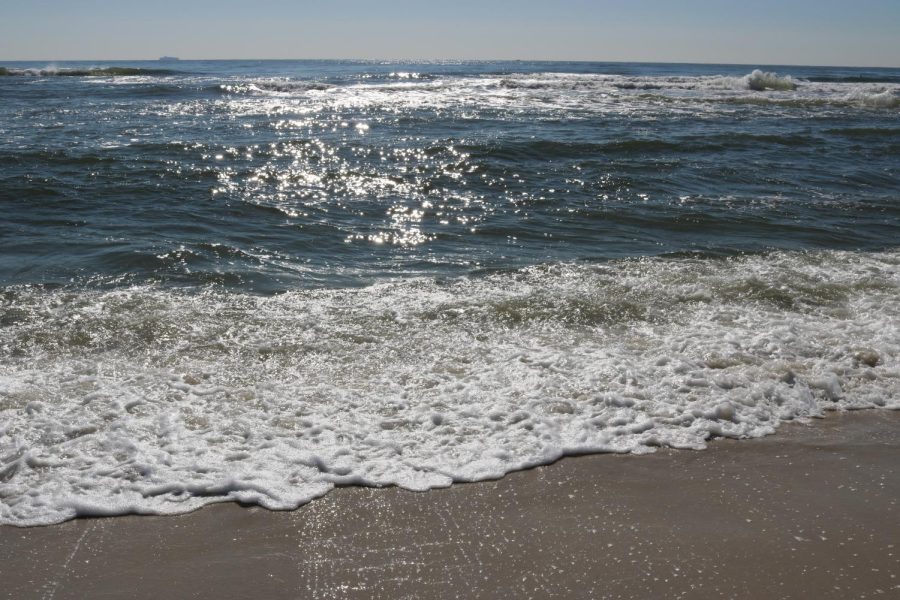What If There’s Something Worse Than Hurricane Sandy?
Many Long Island residents remember Hurricane Sandy, but will we be capable of handling something worse brought on by climate change? The Red & Black had the opportunity to communicate with ABC Chief Meteorologist Ginger Zee to learn more.
Photo by Kristin Carlson
Storm surge has had an impact on our local beach line.
This year marks the 10th anniversary since Hurricane Sandy struck Long Island, and other areas on the coast. If you ask Long Island residents about Sandy today, many remember the storm like it was yesterday.
In October of 2012, on Long Island alone, approximately 100,000 homes were destroyed and thirteen people were killed, with others injured as was reported by abc7ny.com. Extensive flooding and intense winds caused devastating damage from the Caribbean Islands to the east coast of the United States.
Ron Schuster, a science teacher at Patchogue Medford High School, recalls waiting out the storm with his 9-year-old son. He explained that luckily his house “sustained minimal damage” despite trees falling dangerously close to his home, but they “lost power for 26 hours.”
However, others were not so fortunate as to emerge unscathed.
According to Ginger Zee, the Chief Meteorologist for ABC News, “Superstorm Sandy changed the coastline.”
Sandy caused devastating damage, from sand displacement and property damage on the barrier islands along the Jersey Shore, to severe flooding from Long Island and lower Manhattan all the way to Piermont.
At the time, Zee covered the storm from Atlantic City, New Jersey where she watched as their “historic boardwalk was dismantled,” and she later traveled up to Sea Bright and witnessed how the communities were overwhelmed by the “long push of water.”
Once the storm had passed, surveying the damage left in its wake was heartbreaking. Aspects of Long Island, and many other areas, were unrecognizable due to the flooding and winds that caused such destruction.
Mr. Schuster, a passionate surfer, was faced with road and bridge closures that prevented him from returning to the beach. As he traveled, he was faced with the effects of Sandy, including erosion so severe that he reported that “water breached the dune and pushed sand across Ocean Parkway.”
Once he finally returned to his “surf spots,” and saw the drastic changes in the beach he said that “looking at the damage was painful, like seeing a friend hurt.”
Luckily, meteorologist Ginger Zee explained, that to relieve this seemingly irreversible damage, “adaptation plans” were put into place, and hundreds of millions have been spent on “fortifying these vulnerable beaches.”
She added that even today the Army Corps of Engineers are working on beach nourishment and planning, which have been the “largest projects that are still not complete in Manhattan.”
Fortunately, while Sandy still affects New York, and other coastal states to this day, a great deal of the damage has been corrected.
After such a traumatizing experience, who would want to live through another severe hurricane?
Unfortunately, due to climate change, over time hurricanes could grow more severe and cause unimaginable damage.
Ginger Zee states that “attribution to human induced climate change leads science to connect the severity of storms to climate change.”
Hurricanes are tropical storms fueled by heat and moisture produced by the ocean that intensify into destructive storms with high winds, reaching 75 mph. As climate change causes an increase in heat and moisture produced by the ocean, tropical storms can grow to terrifying power with high wind speeds.
However, Zee explains that the number of cyclones, which is a generic term that encompasses typhoons, hurricanes, and cyclones, “decreases in computer modeling as the atmosphere heats up because there is less difference in temperature as you go higher in the atmosphere which means less convective starts and fewer cyclones.”
On the other hand, once they do form, “water temperatures and lack of wind shear” allow cyclones to quickly intensify and “reach destinations farther north.”
In other words, even if less cyclones form, once they develop, they grow to devastating power that can cause greater damage over larger areas.
Hurricane Sandy alone cost billions of dollars due to the damage it caused, and it was only a category 3 out of 5 storm.
Schuster adds that everyone shares the costs of storms through “increases in taxes or insurance premiums.”
If storms grow more severe, not only will they cost billions of dollars more, but they will also cost more lives, homes, and the well-being of the environment.
Although hurricanes may not seem like an imminent threat, once deadly hurricanes develop it will be too late to stop them or escape the damage. Long Island is especially susceptible to severe damage, and its residents should view this as an urgent issue.
It’s important to make efforts now to prevent such storms from developing by handling climate change.
Ginger Zee advises those looking to make a difference to focus their time, votes, and energy on supporting renewable energy because it’s where “we can have the biggest impact.”
The longer that climate change is left unchecked, the more treacherous environmental threats, such as massive hurricanes, and much more become.







Mr. Hanley • Jan 3, 2023 at 5:20 pm
Love this! Well written article about a very important topic.